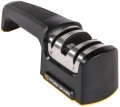Max. grain
The largest grain size of the abrasive surface provided in the design of the sharpener (or among the replaceable whetstones supplied as standard).
See “Min. graininess" above. This parameter is indicated only if the sharpener has several abrasive surfaces with different grain sizes. The greater the difference between the minimum and maximum graininess, the more universal this model is, usually, the more options it offers in terms of processing intensity. On the other hand, a wide variety of abrasive surfaces has a corresponding effect on the cost.
Sharpening angle
The sharpening angle provided by the sharpener. It is indicated only for models whose design provides sharpening at a strictly fixed angle (most often, two abrasive elements are used for this at the appropriate angle to each other). For Lansky and Apex machines (see "System"), as well as for stones (see "Type"), this parameter is not given — in such devices, the angle can be adjusted independently.
The smaller the sharpening angle, the sharper the knife, the easier it enters the material being cut and the better the cut is, especially when working with delicate materials. On the other hand, as the angle decreases, the cutting edge becomes more brittle, requires delicate handling, and dulls faster; therefore, for dense, hard materials, knives with relatively large sharpening angles are used.
As for specific values, in modern sharpeners there are indicators from 15 ° to 30 °. For comparison: Japanese kitchen knives are mainly sharpened at 10 – 20 °, classic chef's — 25 -30 °; and for a folding pocketknife, 30° is still considered a small angle. More detailed recommendations on sharpening angles can be found in special sources.
Serrated sharpening
Possibility of using a sharpener for
sharpening serrated blades.
Such blades have a serrated cutting edge, for which the classical method of sharpening, on a flat surface, is unsuitable: such a procedure will simply erase the teeth and, at best, turn the serrated blade into a classic smooth one. Therefore, for sharpening in this case, special devices are used: thin rods made of abrasive material, somewhat tapering towards the end. With such a rod, each individual tooth is sharpened separately; this work can be quite laborious, but it allows you to restore the full performance of the serrated blade. At the same time, note that for blades with fine teeth, even such a specialized sharpener may be too large.
Sharpening scissors
Possibility of using a sharpener for
sharpening scissors.
Technically, you can sharpen scissors on almost any sharpener — the design of their blades is not very different from knife ones. However, individual sharpeners may provide various design solutions that make it easier to work with scissors — for example, the ability to set the optimal sharpening angle or special mounts for such a tool. Therefore, for maximum convenience when working with scissors, you should still choose models where this function is directly stated.

